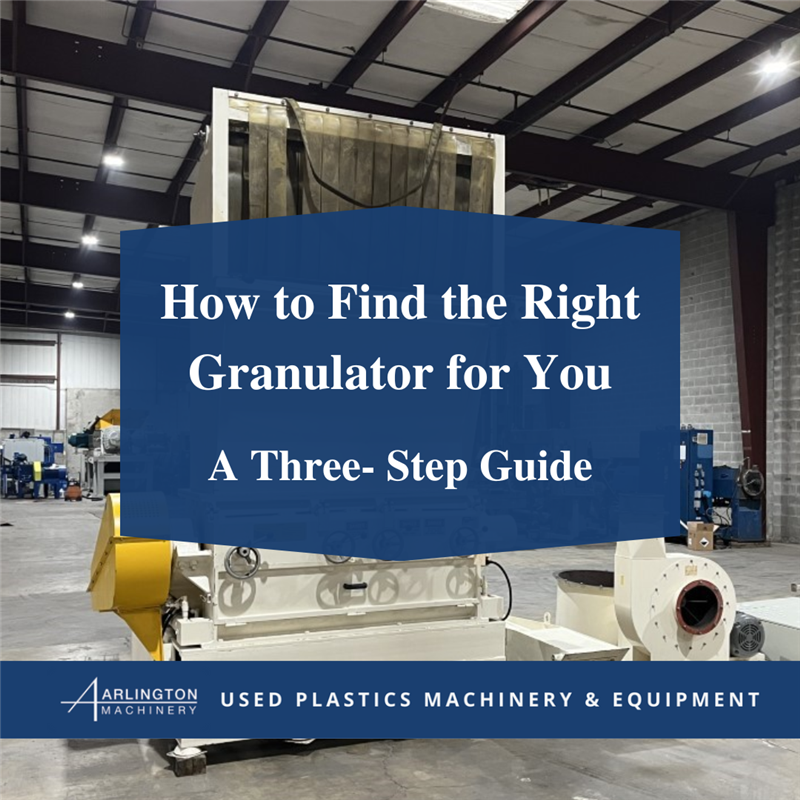
If you are looking for a granulator at an affordable price, you need Arlington Machinery. With these three simple questions, we can guide you towards the right granulator for you. There are countless simple and advanced options available, each with unique benefits and requirements. Whether you are new to granulating or simply expanding your capabilities, a granulator suited to your exact needs is more than worth the search. Let’s take a deep dive into what you need to know before selecting your equipment.
For more information on any machine, our services, or how we can fulfill your business needs, give us a call at (847) 956-7300.
What Do I Need to Granulate?
The first step is understanding your material; before you can begin crafting, it is important to identify your materials as thin, thick, rigid, soft, or somewhere in between. Fillers, material type, and percentages of each type are essential points to consider as well. In most instances, your feed stream and horsepower requirement will depend on all of these factors.
Most importantly, the type and texture of your materials dictate what type of rotor blade you need. There are four main types of rotors, each with unique benefits for specific types of material.
Rotor Blade Configurations
| Open | Provide unrestricted airflow through the cutting chamber | Great for: heat-sensitive materials or feedstock |
| Closed/Solid | Stronger knife mounting arrangement and adds inertia to cut through thick materials | Great for: thick feedstock or large cold purgings |
| Staggered | May include flywheel pulleys for increased inertia without increased horsepower | Great for: heavy, thick-walled materials |
| Staggered | Offer more cuts per revolution than traditional designs | Great for: thickest and heaviest parts |
Granulators also host different knives, all of which vary in arrangement, size, sharpness, and angle for individual purposes. In general, sharper knives are required for more brittle materials, and blunt knives are ideal for softer materials. Adding more knife blades can increase throughput because it increases cuts per revolution. Slant knife arrangements may also be available on certain models, which can provide decreased fines and dust, less noise, and reduced horsepower requirements.
What Is My Granulation Goal?
Knowing the physical shape and size of raw materials compared to the end goal will help determine the chamber dimensions, chamber shape, and quantity of fly knives. Hopper dimensions and angles must also be considered to ensure proper feeding of the machine. At this time, thinking about your target throughput rate will point you towards the correct pounds per hour (lbs./hr.) requirement.
A granulator relies on a rotor and blades in the cutting chamber, which largely dictate the reduction performance. There are four basic cutting chamber designs with a good amount of overlap between their capabilities. Reviewing these points can narrow your granulator search before moving on to the next step.
Cutting Chamber Configurations
| Tangential | Conventional Offset | Straight-Drop | Combination |
|---|---|---|---|
| Rotor is offset from feed opening | Directs material at a perpendicular angle to the rotor | Feeds material down from the top | Combined gravity-fed chamber with large bite |
| Offers a larger bite radius | Not recommended for thin materials | Minimizes the size of the bite | Raised bed knife option is ideal for heavy parts |
| Great for: high throughput for bulky and thin materials | Great for: thick-walled and high-density materials | Great for: heavy materials, thick cross-sections | Great for: heaviest materials |
How Do I Intend to Feed and Evacuate the Machine?
Some granulators can be hand-fed, but others may require a conveyor. Depending on your materials, you may also need different screens for regrinds. When the rotor is operating at a lower speed, a thinner and smaller-holed screen is ideal for uniformity and increased throughput. At higher speeds, you will need larger screen holes to manage fines; this must be balanced with your goal particle sizes.
Also, the evacuation method must be considered. Depending on your materials, you may need a manual bin discharge, suction or push blower, or flat belt and auger conveying systems. If you are unsure about which evacuation method is ideal for your materials, please reach out—we can help. We have decades of experience matching businesses with the equipment they need to get the job done.
Now What?
After identifying your granulation requirements, check out our collections of used granulators, new granulators, and their necessary parts and rotors. Inside each listing, you will find its dimensions, technical information, and test run status. If your goal is to product the highest quality product with minimal scrap and waste, minimizing machine cycle time and human contact should be top of your to-do list. In order to achieve these goals, your machinery must be up to date and primed for your specific needs.
If you have questions, we have answers. Give us a call at (847) 956-7300 and let us show you how we can help you find your next granulator. Follow us on social media for live updates on what’s new in stock, industry news, and more.
